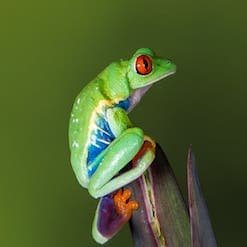Some observations by a former Judge Alex Fyfe DPAGB
Judge and be Judged
Some observations by a former Judge – Alex Fyfe DPAGB
Some General Considerations.
Having spent some time both judging and being judged, I offer the following thoughts on this thorny subject.
At a recent club night we all benefited from trying to look at our pictures through the judge’s eyes and we tried to get under the skin of this character we call THE JUDGE. The very name conjures up an image of someone who is both critical and negative and this is far from a true picture of the average judge we get for our monthly competitions. We do have to accept however that some judges are better than others, remembering that in the main, judges themselves are ordinary members in their own clubs and do the job voluntarily for no remuneration other than travel expenses.
Kermit the frog (of Muppet Show fame) confessed in a song that ‘It’s not easy being Green’. Having done some judging myself for a few years I have to confess that in my limited experience it’s not easy being a judge, regardless of colour. I just haven’t found a way to say it in song. Yet! The judge can only please a very few of those who submit their work to his gaze (the winners), and club members are often justifiably critical of the judge for giving a superficial assessment of their work. The judge is often on a hiding to nothing, knowing all too well that he/she is also being judged as they perform their task. You don’t have to be a masochist to be a judge but it certainly helps! The scoring system, which is a subject in itself, can also leave the entrant unsatisfied by awarding a place, and the appropriate points, to the 1st, 2nd, and 3rd, and leaving everyone else wondering how their picture fared on the scale of marking. If in addition, the entrant gets no helpful feedback from the judge, then it’s understandable that they will feel little benefit from entering the competition. This is not all the judge’s fault but he/she is likely to attract most of the ensuing flak.
Some General Requirements.
So what do we have a right to expect from our much maligned judges? I read the following extract from the letters page of a well known photographic magazine which gives one point of view. ‘To judge and criticise constructively demands a depth of knowledge at least equal to that of the author of the work. In the case of a competition, the judge’s expertise should at least equate to that of the best exhibitor’.
This appears quite reasonable at first reading but if this were to be applied as the accepted norm I fear we would quickly find ourselves with an acute shortage of people coming forward to take up the judging challenge. There must be an entry level for judges. They don’t all start off as experts though it is hoped they would improve as they gain more experience. This inevitably means there will be some disappointments. There is no easy solution. The generally accepted compromise, which is what we have now, is to set the bar of expectation for the judge a little lower, remembering that our photography is a ‘fun’ activity and the competitions we have are best not taken too seriously. There are other Competitions and National Exhibitions that cater for those who want and enjoy a more cut and thrust style of competition.
Whatever height we set the bar to be eligible to judge, I think the following notes would be a minimum requirement that would satisfy most of our club competition needs.
1) Any aspiring judge should demonstrate a love, even a passion for good photography and be able to appreciate, and be familiar with, its many styles and forms.
2) A personal track record of good photography at an advanced level would be essential otherwise his remarks would be based on theory and little practice.
3) Not essential but highly desirable would be a good working knowledge of a wide range of photographic processes. To be able to talk with the authority of experience on whatever image he might be presented with would be an invaluable asset.
4) A judge should try to be constructive and encouraging and find something positive to say even about a picture he may not like, especially in the Beginners and Intermediate groups.
5) You might find someone who could tick all the above boxes and yet make a poor judge. The final requirement is perhaps the most important of all. The ability to express oneself clearly and communicate in a way that is helpful to the audience, is a skill that most judges strive to attain. Most of our comments about judges hinge on the presence or absence of this ability which it must be said, is generally in short supply.
The Judging Process, and things the judge will look for.
I can only speak for myself, and the following comments are guidelines that I have followed in my admittedly limited experience as a judge. They are not an exhaustive list but one that might give our members food for thought when they are preparing their entry for our competitions and avoid disappointment.
IMPACT
There may be exceptions but most pictures will have an immediate impact on the judge. Sometimes favourable, sometimes not.
Does the picture have real ‘eye appeal’ or is it gimmicky?
Does it show a fresh approach or only repeat what others have already done?
Does a special effect cover up an underlying poor picture?
Has the photographer shown any originality in their treatment of the subject or is it following a well worn path? Traditional can sometimes equate with ‘boring’.
The experienced judge will know in the first few seconds where the picture’s strengths and weaknesses lie and hopefully point these out to us. Over time and with careful attention to the judge’s critique we can learn to avoid the common pitfalls and improve our chances of higher ratings for our work.
CAMERA CRAFT
If the photographer is not making the best of the situation with his camera it will come across in the print and the judge will jump on it. Who is in control of the camera, the photographer, or is everything set on AUTO? Don’t expect to salvage a poorly taken picture with Photoshop. It seldom works. Exposure, focus, and carefully chosen depth of field, are some of the building blocks of good camera technique with no shortage of books and magazines offering help to the beginner in understanding the technicalities and jargon.
COMPOSITION
This is not a technical but an aesthetic consideration and weakness in this area accounts for a high level of judge’s comments. Many otherwise good pictures fail for lack of good composition. Photoshop provides tools that can help us to improve on our original choice of camera viewpoint. There are some general rules of thumb regarding composition that the newcomer would do well to acquaint themselves with and these are part of every photographer’s learning curve.
DEGREE OF DIFFICULTY
Some will dispute that this should be a consideration. Imagine a judge faced with two superb photographs. One, a landscape where the photographer could wait for the lighting to be just right and the clouds to move into the ideal place in the frame. All the time in the world to set the right exposure and point of focus. In the second shot the photographer has caught a fleeting moment of action, enabling us to see the detail of an event that happened in the twinkling of an eye. There can only be one 1st place. Which one wins? The technical demands for both pictures might be the same but the instant response of the second photographer deserves an extra point and for me, merits the winning place.
Some Conclusions
The above points are not an exhaustive list of all the things that go into the judge’s appraisal of our work but serves to give some idea of the thought process going on in the judge’s mind. Some judges make it look so easy and others struggle. This is unlikely to change while we continue to try and apportion marks to something as subjective as a photograph. Most of us took up photography because it was ‘fun’ and allowed us to express our creativity, such as that might be. We would do well not to lose sight of that original motivation by getting hung up about this or that judge’s comments.’ Please yourself’ by all means, but be open to the constructive comments of others, and be willing to learn from their mistakes. It will save a lot of time.
A Word to Judges
All of us sitting in the audience listening to your comments on our work would dearly love to be in that coveted 1st, 2nd, or 3rd group at the end of the evening. More than that, we want to learn something from your remarks that will help us make better choices next time we are faced with a great picture opportunity. It’s not all about points. The whole exercise should be a learning experience and you are ‘the teacher’. You only have about two minutes at most to say something meaningful, so don’t waste it by describing the picture as though we were blind and can’t see it, or by reminiscing about yourself. Do avoid the repetitive use of stock phrases such as ‘well seen’. And please don’t talk to the picture. Take a long hard look at it, decide what you want to say, turn to the room and talk to us. Too often we see the back of your head and your voice is lost, especially if you are hard of hearing, as I am! All that said, I have to add our thanks to you. You were willing to come and give us the benefit of your experience and many of us are the better for it even if your remarks are sometimes less than we’d hoped for. Like the rest of us, you too are on a personal journey, and nobody said it would be easy.
Finally
We all know instantly whether we do or don’t like a picture. To be able to spend around two minutes explaining exactly why……. is a very different story, especially if there are another 50/60 pictures to be considered in the same session. My final word on judging is therefore….’Don’t knock it till you’ve tried it’.
Alex Fyfe DPAGB September 2010




